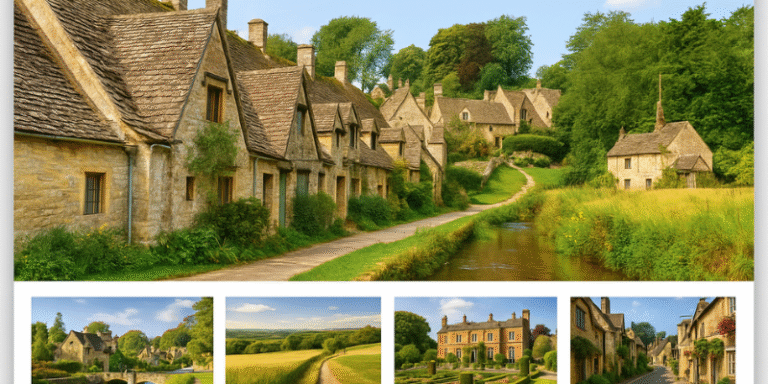The Cotswolds, stretching across six counties in south-west England (principally Gloucestershire and Oxfordshire), is a region celebrated for its rolling hills, golden limestone villages, and quintessentially English charm (Wikipedia, 2025a). Covering nearly 800 square miles (about 2,038 km²) within the designated Cotswolds National Landscape, it has offered generations of visitors a peaceful escape in bucolic surroundings (Wikipedia, 2025a).
Established as an Area of Outstanding Natural Beauty in 1966, the region preserves rare Jurassic limestone grasslands, ancient woodlands, and architectural heritage that ranges from Neolithic burial mounds to wool‑churches dating back to the medieval wool trade (Wikipedia, 2025a). With over 3,000 miles of footpaths, the Cotswolds encourage both leisurely strolls and more rigorous walking adventures (Wikipedia, 2025a).
The Timeless Appeal: Villages, Landscapes, and Local Life
Villages such as Bibury, Bourton‑on‑the‑Water, Chipping Campden, Stow‑on‑the‑Wold and Broadway embody the honey‑coloured Cotswold stone aesthetic, retaining traditional architecture and village charm (Kelly Prince, 2025; Wikipedia, 2025a). Bibury’s famous Arlington Row cottages date to the 17th century and remain one of England’s most photographed scenes, drawing huge crowds—sometimes up to 10,000 visitors a day—creating friction between tourism and residents (Wikipedia, 2025a; The Sun, 2025; The Sun, 2025).
Bourton‑on‑the‑Water, often nicknamed the “Venice of the Cotswolds”, welcomes around 300,000 visitors a year, far exceeding its permanent population of under 3,500, and features attractions like a model village, motoring museum, and a river‑bank village atmosphere (Wikipedia, 2025a; Wikipedia, 2025b).
Local cases such as Chipping Campden illustrate how tourism and inward migration shape community dynamics. Anthropological studies show that imagined ideals of ‘Old England’ attract retirees and outsiders whose presence reshapes local social relations (Fees, cited via OpenEdition, 2010; Journal of Viatourism, 2010). Such change can bring both cultural enrichment and tensions.
Tourism Scale and Sustainability
The Cotswolds receive approximately 25 million visitors annually, generating significant economic benefit but also posing pressures on heritage sites, landscapes and local communities (Cotswolds Tourism Plan, 2022; Wikipedia, 2025a). In 2016, the wider Cotswolds tourism economy was estimated at over £1 billion, supporting around 200,000 jobs across attractions, accommodation and local services (Wikipedia, 2025a).
Yet, overtourism is becoming a pressing concern. Villages like Bibury and Bourton‑on‑the‑Water suffer crowding, coach congestion, and disruption to everyday life—prompting local bans on large coaches and new infrastructure rules to protect both residents and heritage (The Sun, 2025; The Sun, 2025).
Heritage tourism research emphasises the need for sustainability indicators to manage built heritage and rural tourism responsibly (Ren, 2018). The region’s Tourism Destination Management Plan calls for spreading visitors seasonally and geographically, encouraging sustainable transport, reducing carbon footprints, and promoting local produce (Cotswolds Tourism Plan, 2022).
Picturesque Villages
Stroll through Bibury for Arlington Row and riverside meadows; explore Bourton‑on‑the‑Water with its low bridges, model village and tranquil river settings; visit Chipping Campden, birthplace of the Arts & Crafts Movement and home to events like the historic Cotswold Olimpick Games (Wikipedia, 2025a).
Landscape and Walks
Take in panoramic views from Cleeve Hill, the region’s highest point, or follow the Cotswold Way—a nearly 100‑mile trail from Bath to Chipping Campden. Walkers can also explore Chedworth Nature Reserve, which runs along a disused railway and ancient woodland, passing the Roman villa and limestone habitats (Wikipedia, 2025a; Wikipedia, 2025b).
Heritage and Gardens
Visit Roman villas such as those at Chedworth and Cirencester for archaeological insight. Browse stunning gardens like Hidcote Manor Garden or Kiftsgate Court for horticultural richness. Visit historic houses and estates in Tetbury, Beverston Castle, or Sudeley Castle, which reflect centuries of architectural history (Wikipedia, 2025a).
Local Food and Culture
Sample local produce—from cream teas and hearty Sunday roasts to organic farm fare at places like Daylesford Organic Farm (Kelly Prince, 2025). Stop by independent shops, artisan markets, and cosy pubs such as those in Burford, Minster Lovell, or Witney, all offering authentic local hospitality away from the busiest tourist hubs (The Sun, 2025; Kelly Prince, 2025).
Off‑Beat Gems
For a quieter experience, visit less crowded spots such as Witney, known for antiques shops and local eateries; Minster Lovell, with thatched cottages and riverside ruins; or Woodstock, close to Blenheim Palace, offering riverside pubs and historic charm (The Sun, 2025).
Balancing Charm and Conservation
While the imagery of fairytale England makes the Cotswolds irresistible, management authorities stress the importance of heritage conservation and local wellbeing. The 2022 Tourism Strategy seeks to reduce high‑density visits to fragile sites, encourage respect for everyday residential life, and foster long‑term sustainability (Cotswolds Tourism Plan, 2022).
Academic research supports these aims: applying sustainability indicators to built heritage helps guide policy choices and tourism planning (Ren, 2018). Strategies include promoting off‑peak visits, encouraging visitors to explore lesser‑known villages, and supporting locally owned businesses (Journal of Viatourism case study; Ren, 2018).
Visitor Tips for a Rewarding Experience
- Visit off‑peak or midweek to avoid heavy crowds at villages like Bibury and Bourton‑on‑the‑Water.
- Explore beyond the highlights—discover less popular villages like Minster Lovell or Witney for a more peaceful and authentic experience.
- Walk or cycle on footpaths and trails (Cotswold Way, nature reserves) to immerse in the landscape.
- Support local businesses: enjoy farm‑to‑table food, independent shops, and local produce.
- Respect community life: observe coach bans, avoid trespassing on private properties like Arlington Row, and be mindful in small residential villages.
- Embrace slow travel: the Cotswolds reward travellers who linger, explore side lanes, chat with locals, and savour quiet moments among the hills and stone cottages.
Visiting the Cotswolds offers more than a quick getaway—it is an invitation to step into a landscape shaped by history, architecture, craft and countryside beauty. From honey-stoned villages to sweeping hills and lush gardens, the region appeals equally to lovers of heritage, walkers, foodies and those seeking replenishment in rural tranquillity. As tourism continues to grow, the key lies in a balanced approach—experiencing charm while preserving its essence. Thoughtful travel in the Cotswolds means exploring beyond the crowds, supporting local culture, and leaving the landscape as timelessly inviting as the day you arrived.
References
Cotswolds Tourism Plan (2022) Cotswolds Tourism Destination Management Plan 2022, Cotswolds Tourism.
Kelly Prince (2025) ‘The Ultimate Travel Guide to Visiting the Cotswolds, England’, Kelly Prince Writes, accessed July 2025.
Ren, W. (2018) ‘Indicators for Assessing the Sustainability of Built Heritage Attractions’, Sustainability, 10(7), paper 2504.
Fees (1996) cited in Tourism and Migration in the English Countryside, Journal of Viatourism (OpenEdition, 2010).
The Sun (2025) ‘Residents of Arlington Row in Bibury complain about overtourism’, The Sun, 3 July 2025.
The Sun (2025) ‘The Cotswolds becoming English Hollywood—what villagers say’, The Sun, 29 July 2025.
Wikipedia (2025a) ‘Cotswolds’, accessed August 2025.
Wikipedia (2025b) ‘Bourton‑on‑the‑Water’, accessed August 2025.
Wikipedia (2025b) ‘Chedworth Nature Reserve’, accessed August 2025.
Journal of Viatourism (2010) Tourism and Migration in the English Countryside case study, accessed via OpenEdition.









